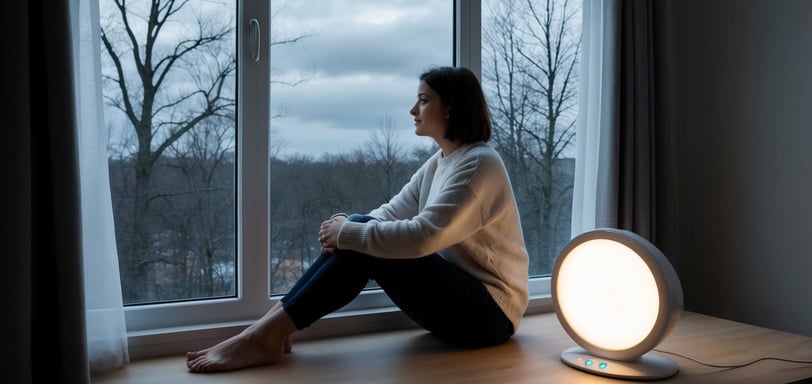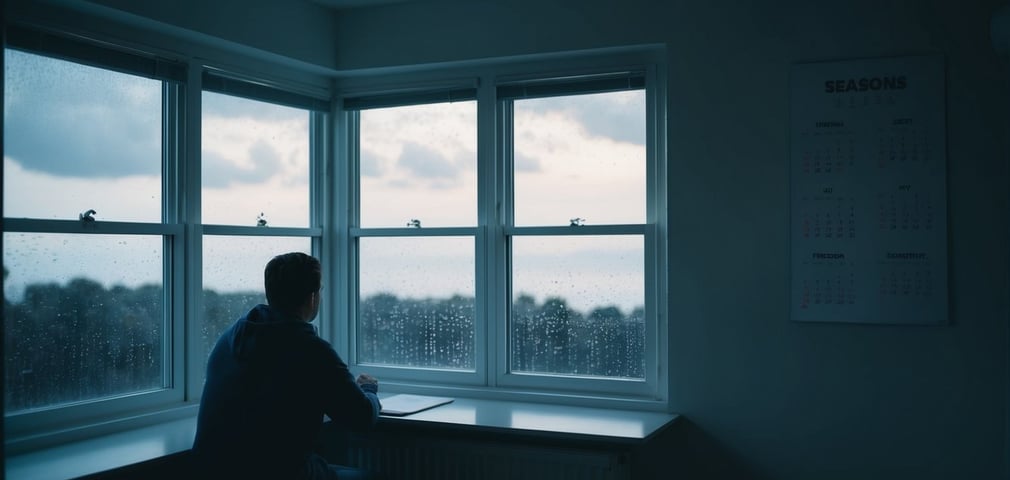Understanding Seasonal Affective Disorder: Key Causes and Effective Treatments
Uncover the essentials of Seasonal Affective Disorder, from its causes to effective treatments. Empower yourself with knowledge for a happier, healthier life!
MENTAL HEALTH
3/9/20255 min read


Understanding Seasonal Affective Disorder: Key Causes and Effective Treatments
Seasonal Affective Disorder, or SAD, can make the darker months feel even more challenging. As the days get shorter and the weather turns gloomy, you might find yourself feeling down, lacking energy, or even struggling to focus. Knowing that SAD is a real condition caused by a lack of sunlight can help you understand that you’re not alone in this fight.
Recognising the symptoms of SAD is the first step towards feeling better. Many people experience changes in sleep, appetite, or mood, and it’s crucial to acknowledge these changes instead of brushing them off. Fortunately, there are various treatments and strategies available to help you manage these feelings and regain your balance during those tough months.
If you've ever found yourself feeling unusually sad in winter, you're not alone, and there's hope. People often find comfort in the idea that, with the right support and tools, the winter blues don’t have to take over their lives. Together, let’s explore what you can do to combat SAD and enjoy a brighter outlook during those cold, dark days.
Key Takeaways
Seasonal Affective Disorder affects many people during winter months.
Recognising symptoms early can lead to better management of the disorder.
Effective treatments exist to help improve mood and mental health during dark seasons.
Understanding Seasonal Affective Disorder
Seasonal Affective Disorder (SAD) is a type of depression that occurs at certain times of the year, typically in the winter months. Knowing its causes and effects can help you recognise and manage symptoms.
Defining SAD and its Prevalence
SAD is a form of depression linked to changes in seasons. It often starts in autumn and continues through the winter. In the UK, about 2% to 8% of people may experience SAD. Symptoms can include feelings of hopelessness, social withdrawal, and changes in sleep patterns. During this time, many people might notice that they have low energy and increased irritability.
While SAD mostly affects adults, children and teenagers can be impacted too. It can disrupt daily life and make it hard to enjoy everyday activities. If you feel down during specific months each year, it might be more than just the "winter blues."
Biological Factors and Circadian Rhythm
Biological factors play a significant role in SAD. One major factor is the circadian rhythm, your body's internal clock that regulates sleep and wake cycles. With less sunlight in winter, your body may struggle to keep this rhythm steady.
Changes in melatonin production can also contribute to SAD. Melatonin is a hormone that controls sleep patterns and is influenced by light exposure. When there is less sunlight, you may produce more melatonin, leading to sleepiness and mood changes.
Additionally, the levels of serotonin can drop with reduced light, which may affect your mood. A genetic predisposition, like a family history of depression, can also make you more vulnerable to SAD.
Psychological and Environmental Influences
Psychological and environmental factors can greatly influence the onset of SAD. The lack of natural light during winter can lead to a deficiency in vitamin D, which is crucial for mood regulation.
Moreover, certain environmental triggers, like being in less sunlight or experiencing colder temperatures, can amplify feelings of isolation. It can feel harder to socialise when you want to stay indoors.
Many people find that using a light therapy box can help. These devices mimic natural sunlight and may improve mood by boosting serotonin levels. Staying active and connecting with friends can also help alleviate symptoms.
Understanding SAD can lead to better management strategies. If you think you might have it, consider talking to a healthcare provider.
Recognising Symptoms and Diagnostic Approach
Recognising the symptoms of Seasonal Affective Disorder (SAD) is important for getting the right help. You might notice changes in your mood and behaviours as the seasons shift. Understanding these signs can help you seek proper assessment and diagnosis.
Common Symptoms of SAD
Common symptoms of SAD often mirror those of clinical depression, but they appear at specific times of the year. Here’s a quick list of what you might experience:
Low Mood: You feel down more often, especially in winter.
Fatigue: You may feel more tired than usual, even after plenty of sleep.
Sleep Disturbances: Changes in your sleep pattern can occur, like oversleeping or insomnia.
Changes in Appetite: You might crave carbs and gain weight.
Irritability: Small things annoy you more than they used to.
Difficulty Concentrating: You may find it hard to focus on tasks.
Anxiety: Increased anxious feelings can accompany your low mood.
If you notice several of these symptoms, it’s worth considering you might have SAD.
Assessment and Diagnosis of SAD
Diagnosing SAD typically starts with a conversation. Your doctor will ask about your mood changes and any patterns related to the seasons. They may inquire about:
Symptoms you’ve been experiencing.
Family history of mood disorders.
Risk factors like geography or lifestyle.
No specific test exists for SAD, but sometimes a doctor will suggest questionnaires to assess your mood. After a thorough discussion, they may recommend treatments like light therapy or counselling, depending on your situation.
It's not always easy to talk about feelings, but it’s a crucial step toward feeling better. Remember, seeking help is a sign of strength.
Exploring Treatments and Management Strategies
Managing Seasonal Affective Disorder (SAD) involves a mix of medical treatments and lifestyle changes. Each option can help improve your mood and overall well-being during difficult months.
Clinical Interventions
For many, the first step is seeking professional help. Cognitive Behavioural Therapy (CBT) is an effective method that helps change negative thinking patterns. Studies show it can reduce symptoms of SAD significantly.
Antidepressant medications, particularly Selective Serotonin Reuptake Inhibitors (SSRIs), can also be prescribed. These medications help balance chemicals in your brain that affect mood. It's essential to consult with a doctor about the best options for you.
Additionally, light therapy is popular for SAD. Using a light box mimics natural sunlight. Just sitting in front of it for about 20-30 minutes in the morning can help boost your mood.
Lifestyle and Well-being Enhancements
Making specific lifestyle changes can also be very beneficial. Regular exercise is key. Aim for at least 30 minutes a day, as physical activity releases endorphins, which improve mood.
Consider adding Vitamin D supplements to your daily routine. A lack of sunlight in winter can lower your Vitamin D levels, impacting your mood. Eating a balanced diet rich in omega-3 fatty acids found in fish can also support mental health.
Exposure to natural light during the day is crucial. Open your curtains and sit by windows whenever possible. Even a short walk outside can make a real difference.
Coping Mechanisms and Support Systems
Finding effective coping strategies is vital for dealing with SAD. Talking to friends or family can provide the support you need. Forming a support group where you can share feelings often helps.
Practising mindfulness and relaxation techniques, like yoga or meditation, can also be effective. These activities can reduce stress and promote a sense of calm.
Lastly, don’t hesitate to explore tools available for help. You can find great resources or products on sites like Amazon UK to support your journey, such as mood lamps or wellness journals. These can aid in managing symptoms and maintaining a positive outlook.






